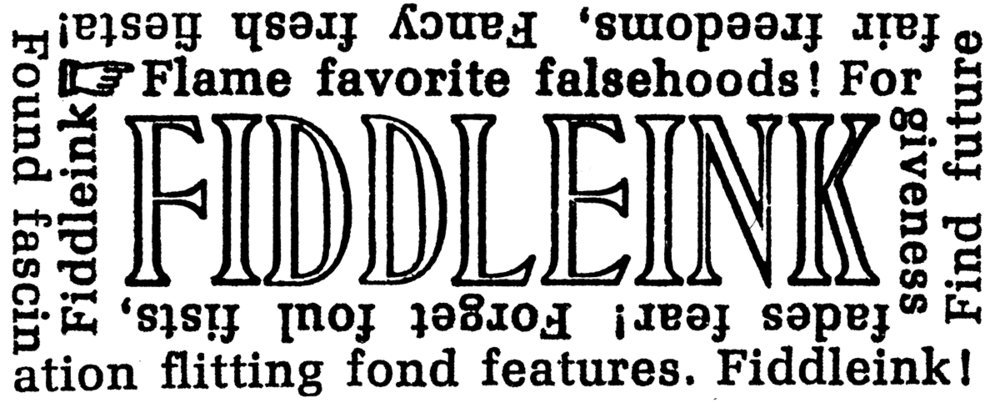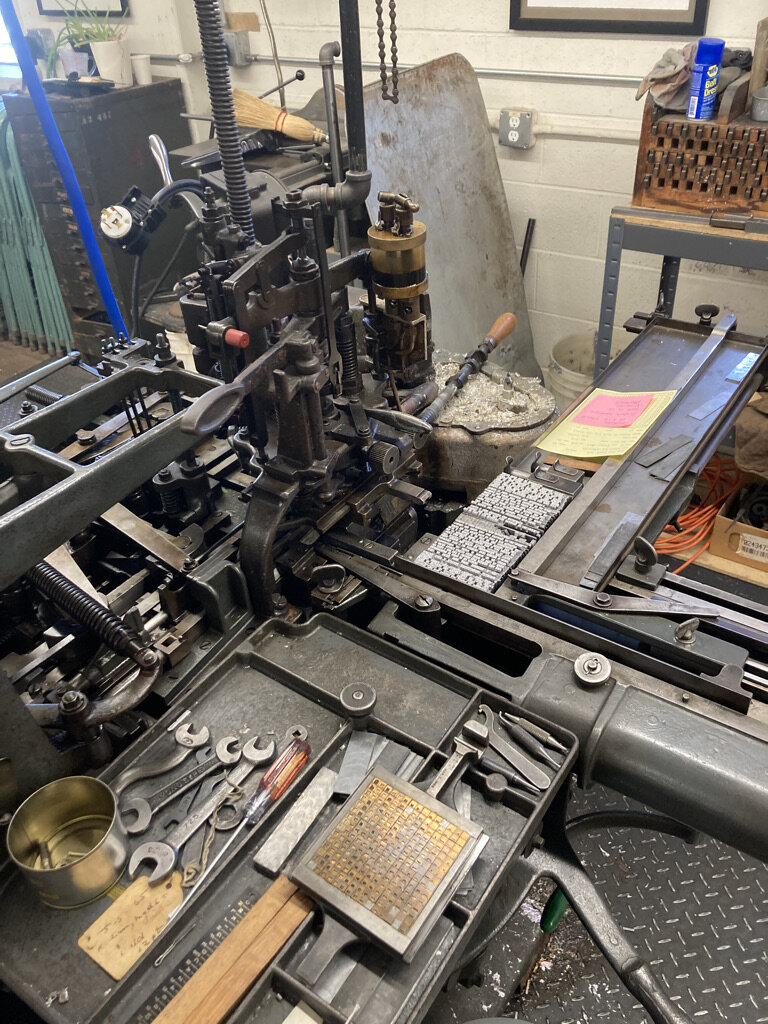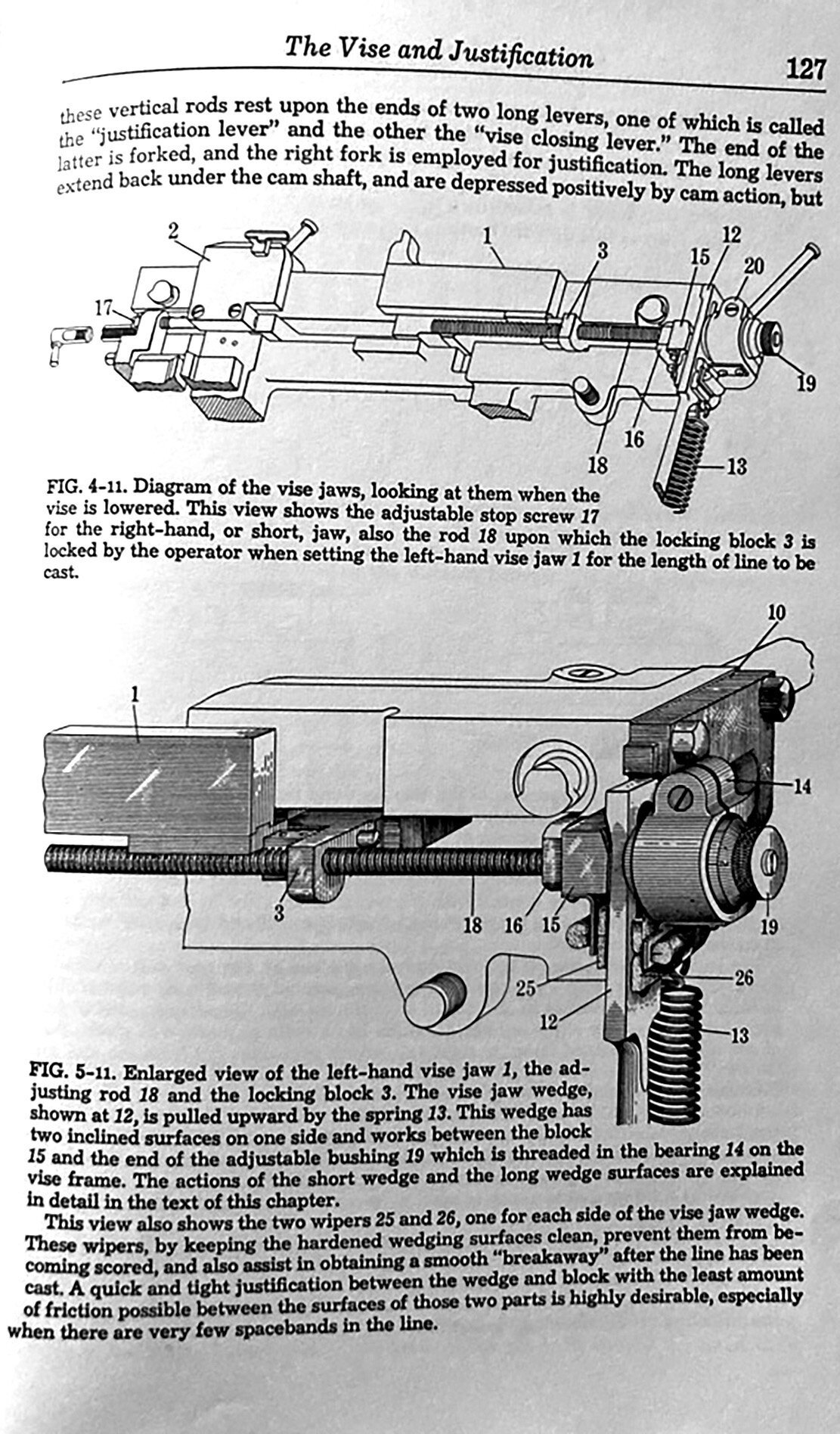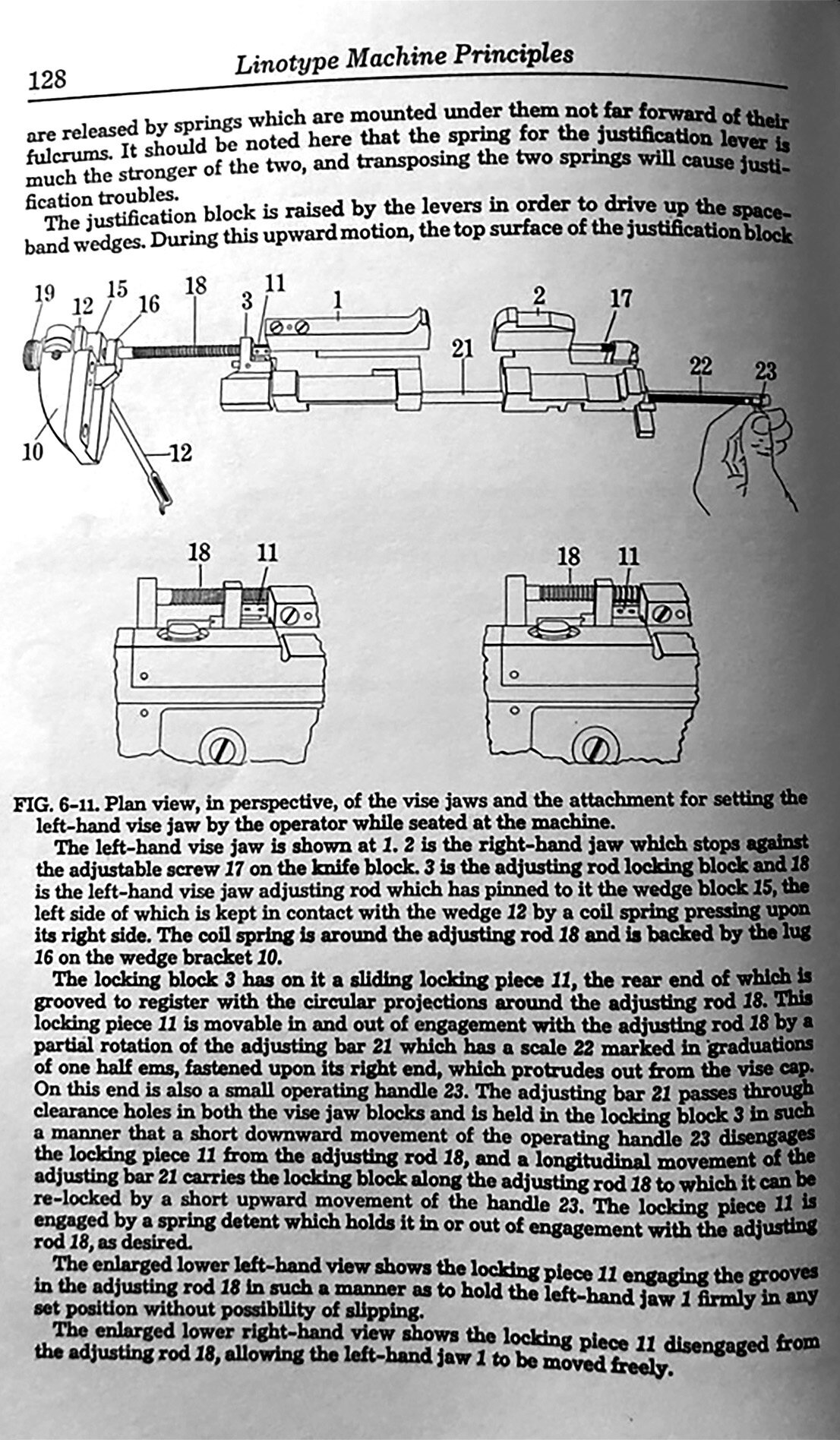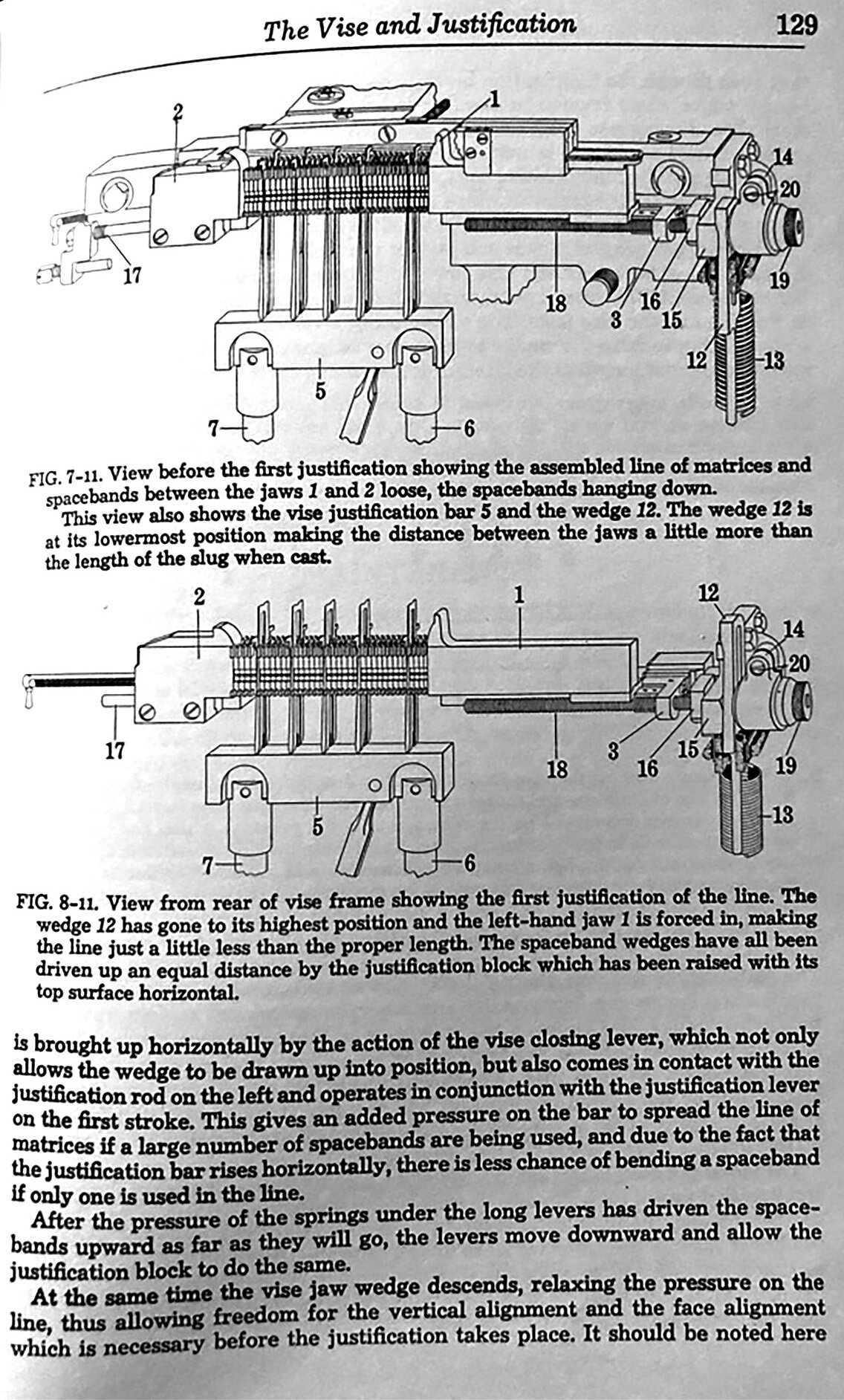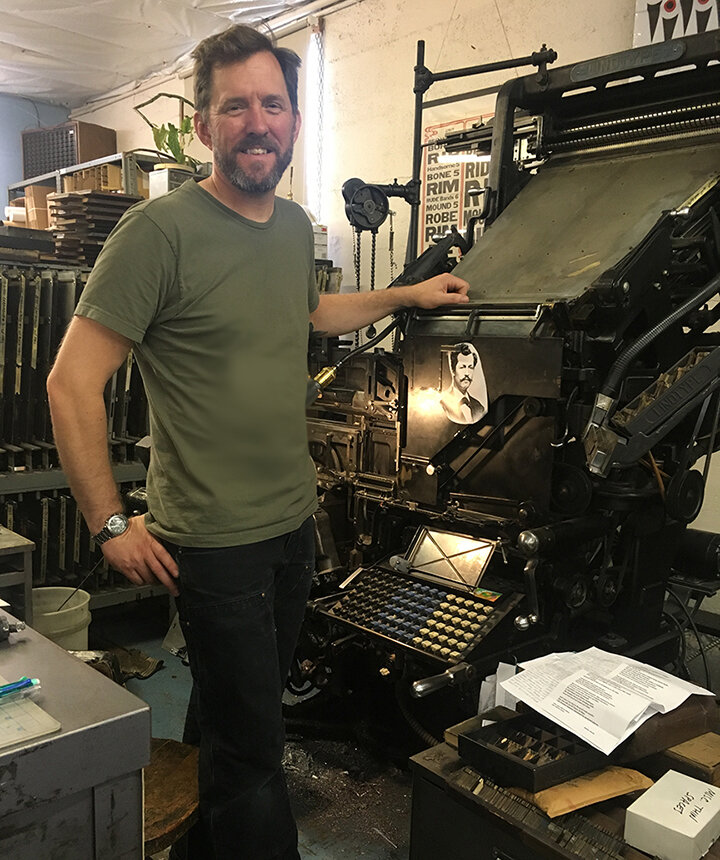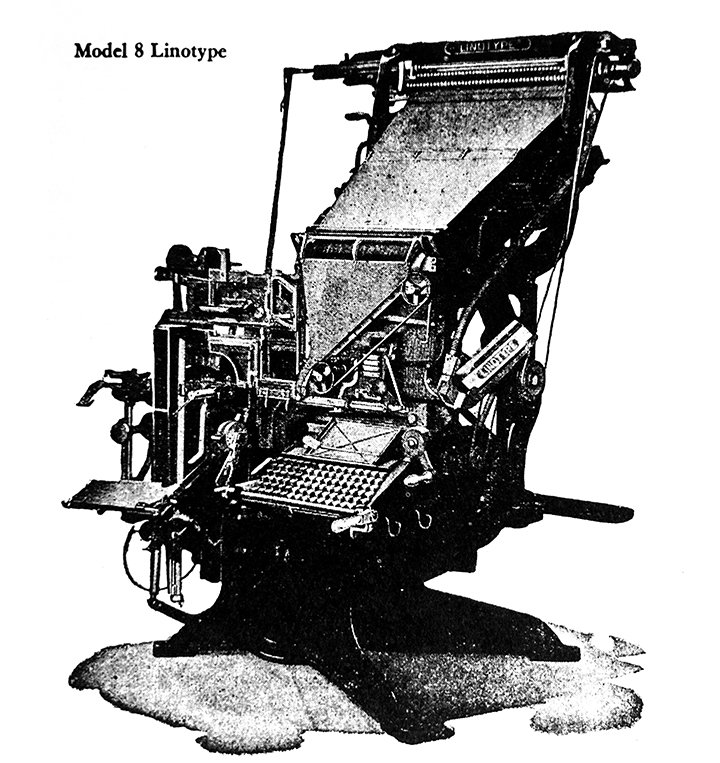During a hike at Eagle Creek well over ten years ago, and well before Eagle Creek caught on fire (but that's another story), my good buddy Marko Whens and I discussed opportunities for collaborating on a print project. At that point, Marko had amassed a collection of his interactive poems, and I had just amassed another chunk of cast iron in the form of a Linotype machine. The machine needed work, and I needed work to move beyond my fledgling knowledge of Linotype machine operation. A deal was struck. After the work day was complete at Stumptown Printers, I would sift through matrices and molds, and use Marko's poems as material to test the machine and my knowledge. Slowly type was set, the machine was repaired and I gained some Linotype chops. But, job work took over and the type was stashed on galleys to gather dust for many years. In late 2018, and once we faced the reality that the increasing cost of rent for the shop was no longer tenable, I rediscovered those galleys and prioritized casting the remainder of the type before the machine would be placed in deep storage. Typecasting was complete, but the shop move took over, and once again the type sat - this time in boxes until our temporary garage shop was finished. The book was finally completed in late 2019. Marko had planned to hold an event in the Spring of 2020 to launch to book release. But, a pandemic happened. So, I'm excited to let you know, that after many years, that book release finally happened on April 2, 2022 at Passages Bookshop. The book is also now available for purchase here on this site. For more details on the book, go here.
C.C. Stern Type Foundry "The Point" 2021 newsletter is in the mail
The 2021 issue of the C.C. Stern Type Foundry Newsletter "The Point" is in the mail. See previous posts here and here) We're pleased with the quality of the type, the metal is consistent, face is clean and weight is solid. We did have an issue with the casting of the exclamation point (this is a "note to self" to check it out when I'm back at the Foundry) it did not print cleanly - I suspect that there is some flashing stuck in the matrix. Luckily we had cast plenty of sorts, and were able to use the best (!) to achieve a satisfactory exclamation.
If you are not on the C.C. Stern Type Foundry mailing list and you would like to receive a copy of "The Point" 2021 newsletter cast and printed with metal type, visit the website and sign up for the mailing list and/or donate (The C.C. Stern Type Foundry is an Oregon 501(c)3 non-profit organization) some funds towards postage. I believe there are about 30 prints remaining after this current mailing.
Typetober
The machines were humming at the C.C. Stern Type Foundry today. Connie, Joe, and Rebecca were working on the comp caster and had success in casting type for our upcoming issue of The Point. Jeff and I filled a Linotype galley with decorative border rule (also for The Point) and type to be used for bookplates. It has been a gorgeous day out here in the Pacific Northwest, made better with the gathering of the type casting crew and happy machines.
Making Waves
Fresh silver. Cast from two matrix slides, wave rule 6pt 134B and regular rule 407. This casting was the result of an afternoon of making adjustments to the Linotype Model 31 at the C.C. Stern Foundry this past weekend. The machine is now in adjustment, and these beauties are ready for ink.
Machine adjustment notes
Problem: border slide block would not cast
Fix: Left and Right vise were slightly out of adjustment when 30 em line was set. At the 30 em setting, the locking block on the adjusting rod was set so that there was excessive space between border matrix slide block and vise which caused the pump stop to activate when attempting casting. Both left and right vise jaws were adjusted, as well as the em scale guide on the adjusting bar.
Comments: There is a wicked looking brazing repair towards the back of the vise closing lever. At some point in this machine’s history, something caused the lever to crack, or perhaps entirely break off. I'm guessing this happened while Don White was operating this machine in his shop under the Morrision bridge years ago. He loved this machine. As I recall, I believe that Don was the original owner, which is a big deal for a small job shop back in the day. I can only imagine that Don’s heart hit the floor right along with the thud of this heavy cast iron lever if that break happened while he was behind the keyboard.
When you see repairs on the machine like this, it sends up the red flags - perhaps this is why the machine is slightly out of adjustment? To prevent what ever caused this break to reoccur? Or did it happen when the vise was lowered to the second position? Just something to ponder before pulling out the wrenches and making bold adjustments. Incremental is the key, and take it slow.
I was happy to (re)discover that the left vise jaw wedge is spring activated, not cam driven, so it gave me a little more confidence that at least the left jaw adjustment wouldn't cause a nasty lever-breaking jam. But again, take it slow, bro. Discovering that spring mechanism was another moment to bow down to the Mergenthaler crew. These engineering features offer yet another a glimpse into the brilliance of Ottmar and his team.
Note to self: Those felts along the left vise jaw wedge need some love.
Following the maintenance steps on page 131, chapter 11 in Linotype Machine Principles, the adjustments were successfully completed, and in the process I ended up with a partial galley of decorative border. Not a bad work day at the C.C. Stern Type Foundry.
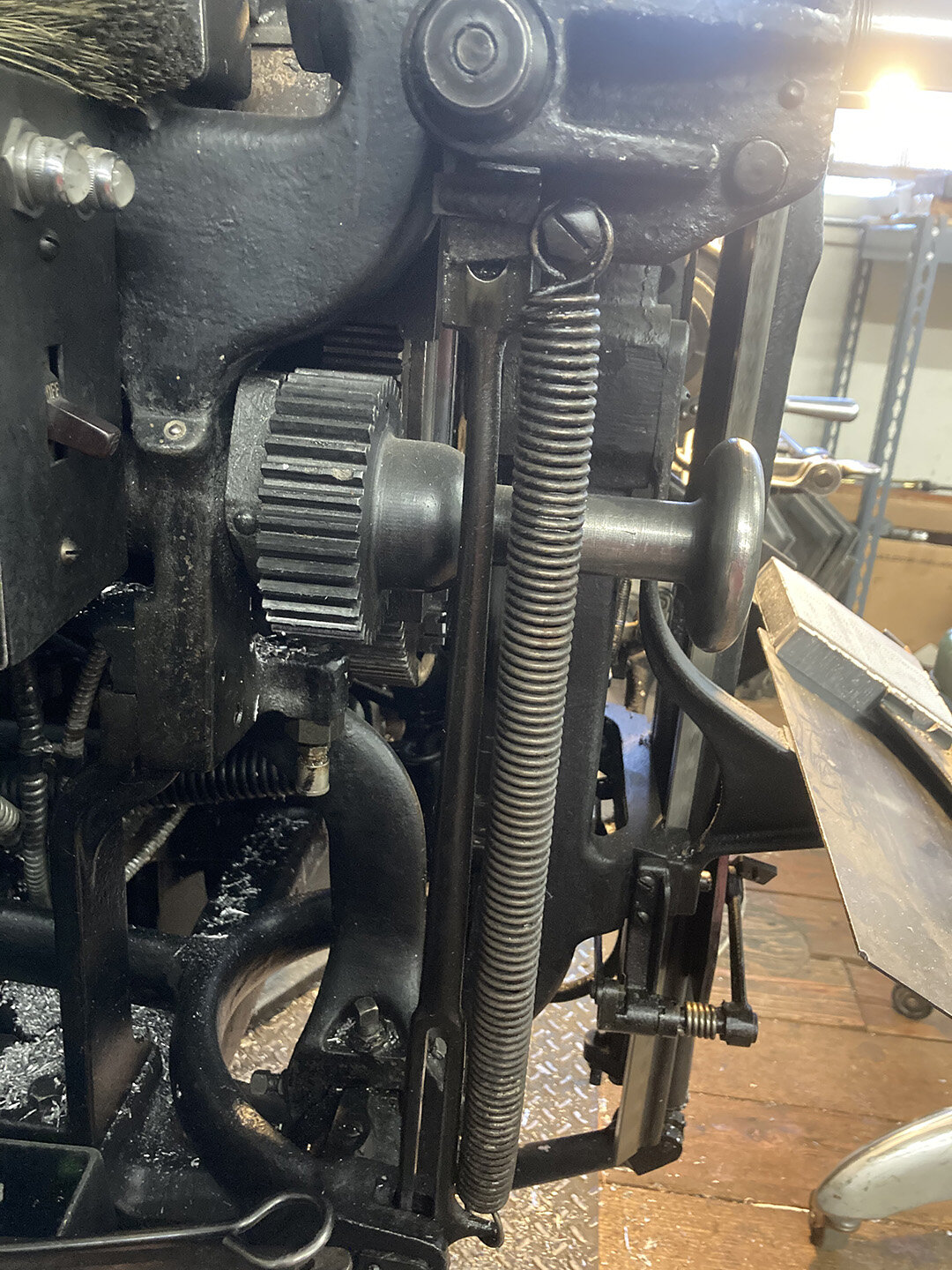
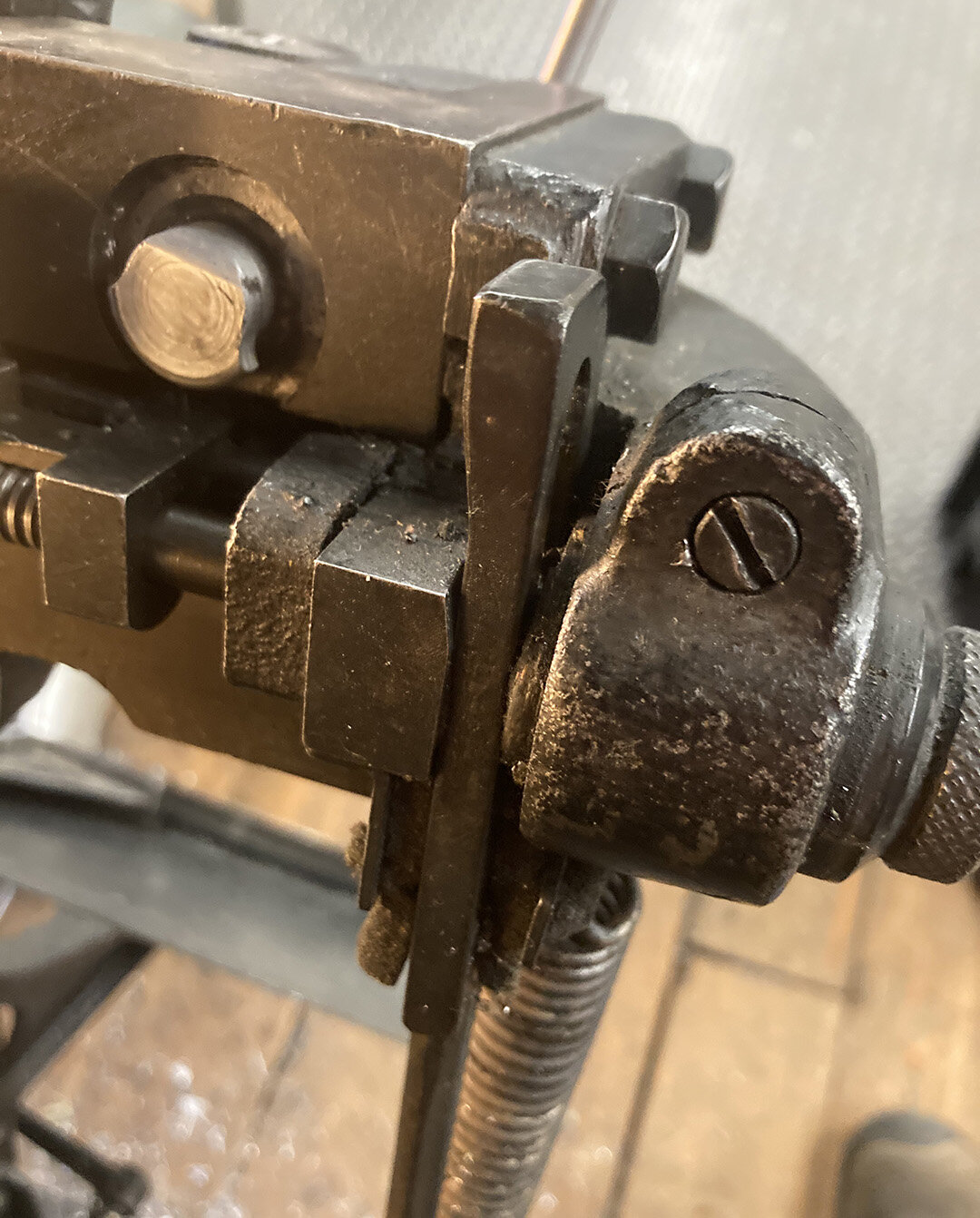
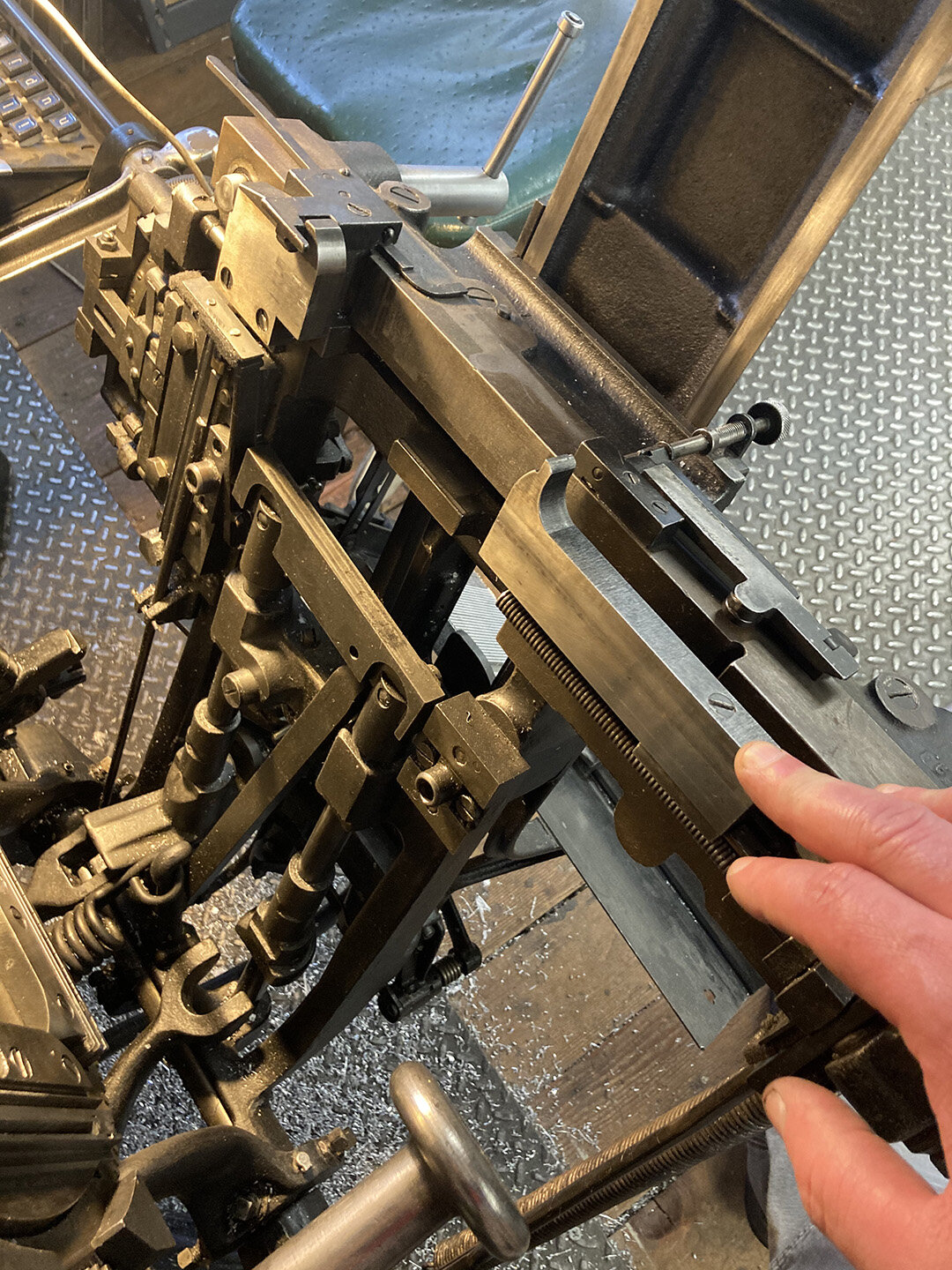
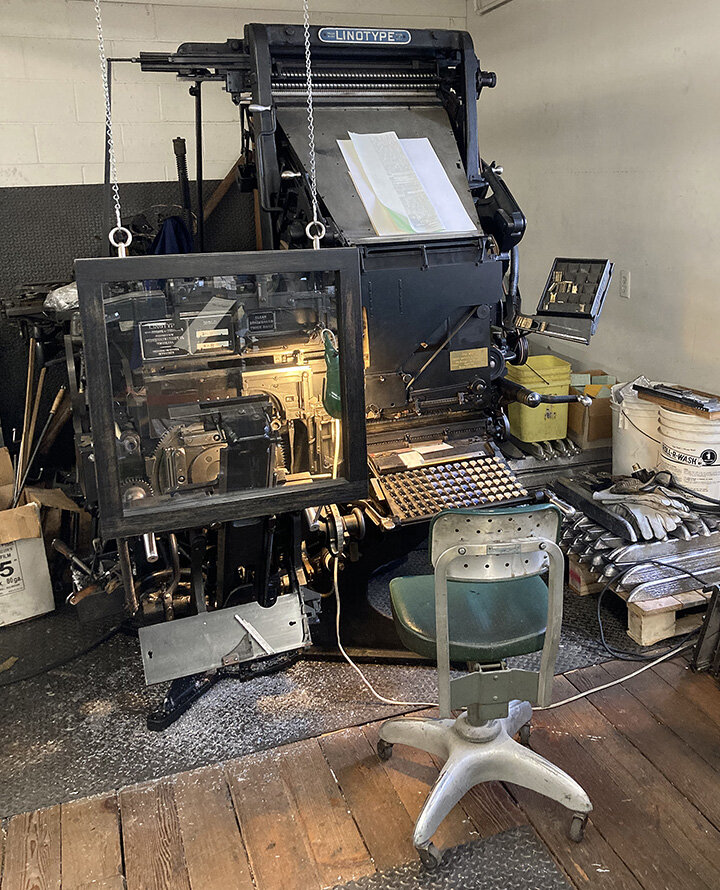
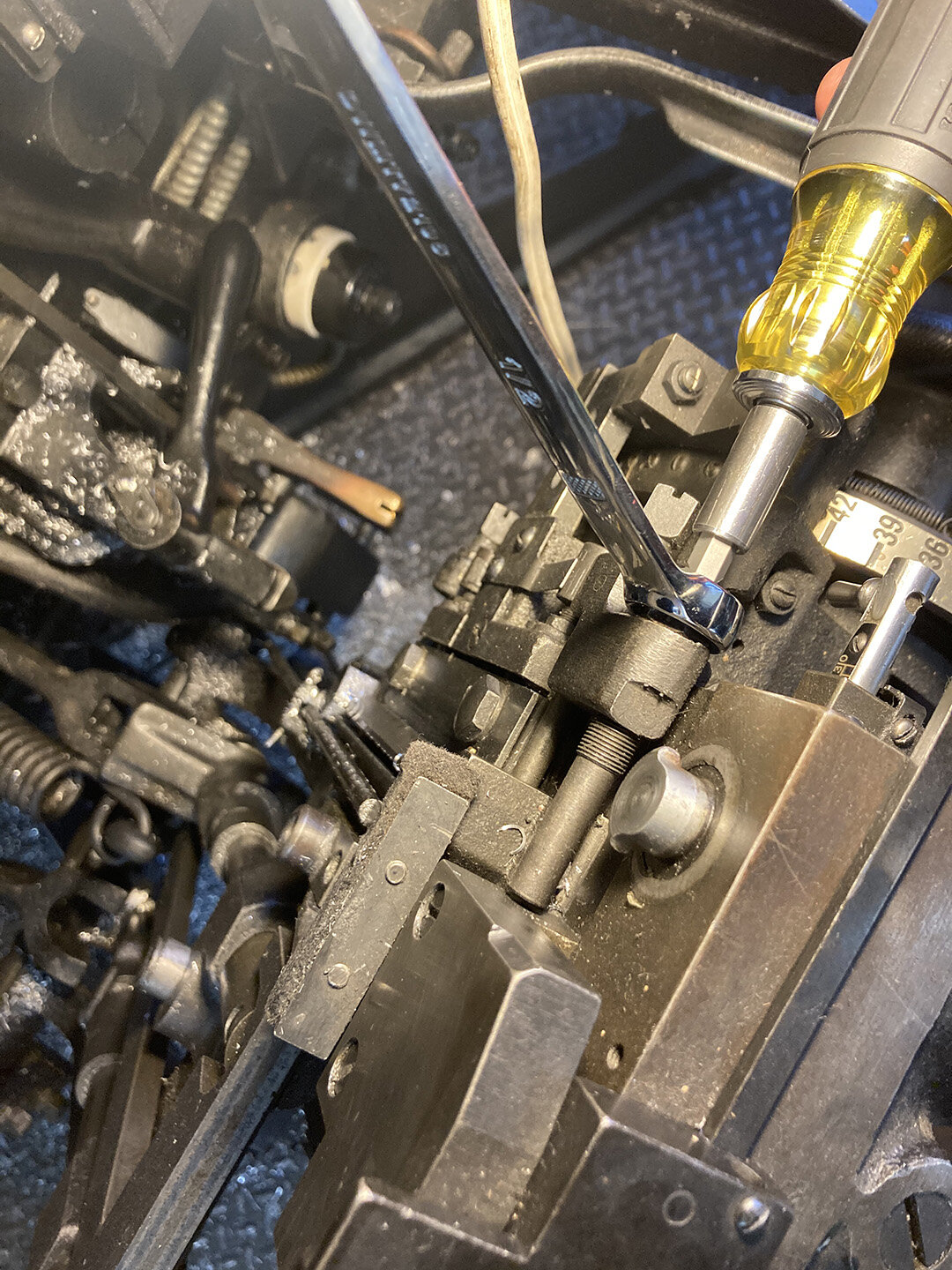
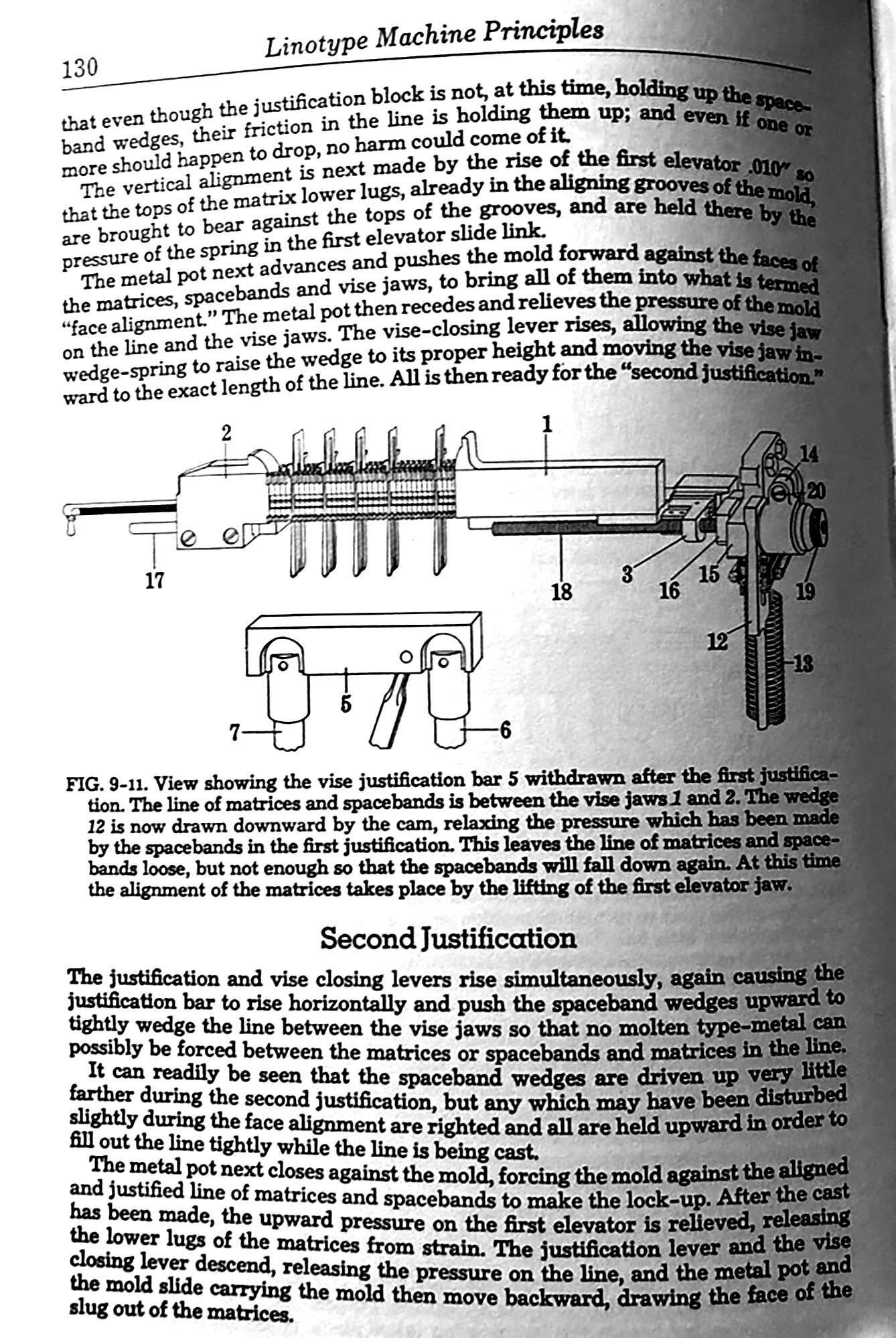
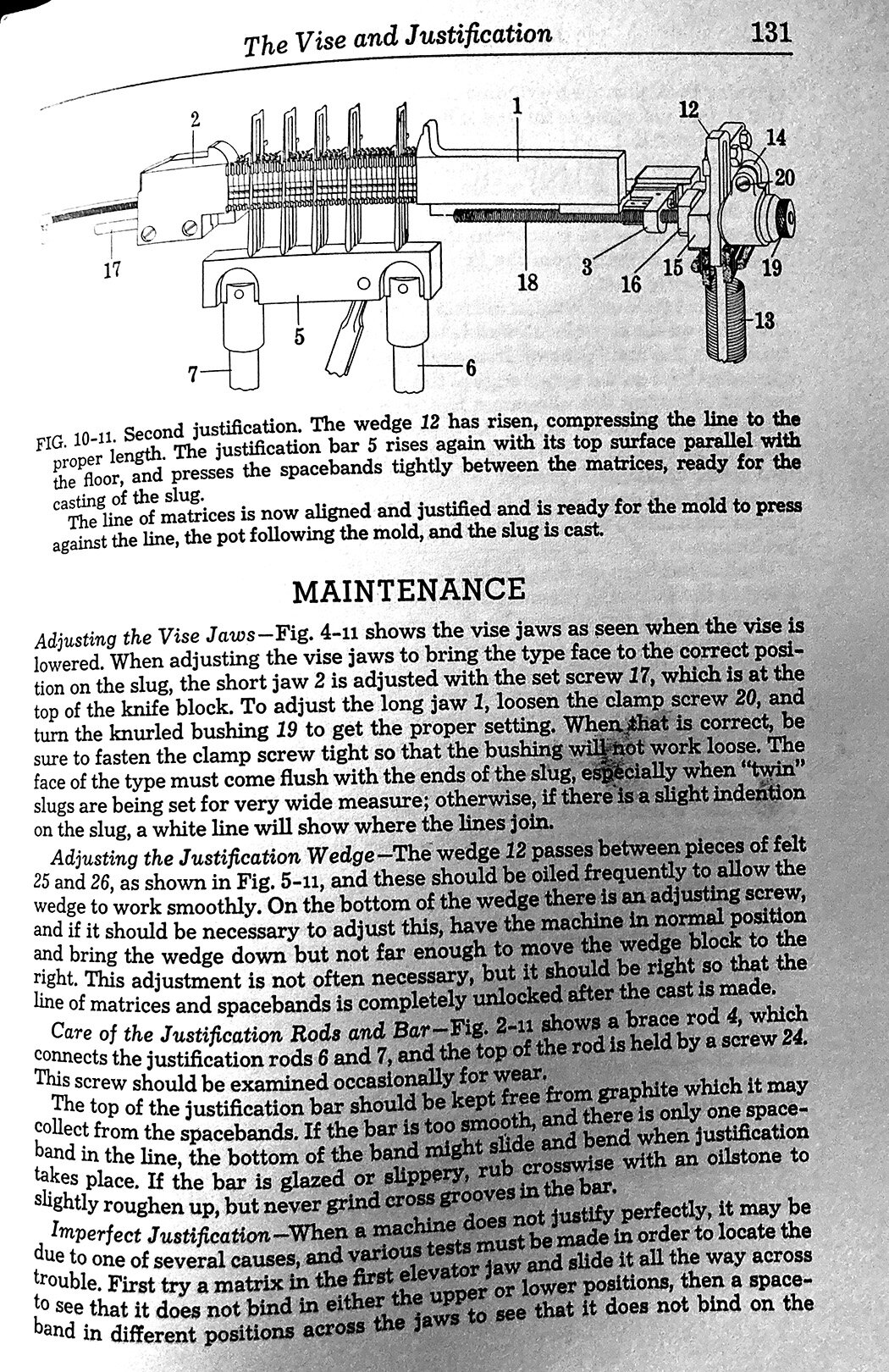
Don't be a Jerk. Read Moby Dick!
Recently, my brother and I challenged (encouraged?) each other to read Herman Melville's Moby Dick. It's something we both have wanted to do, but hadn't prioritized until these quarantine times. So we hatched a plan to read it daily in small sections, roped some friends into reading along with us, and dubbed the project: "Don't be a Jerk. Read Moby Dick!" Pictured above is a sign printed in a very limited quantity to celebrate the reading event.
Photo from Vamp & Tramp, Booksellers
Linotype casting for Barbara Tetenbaum's "Old Friends in Nebraska; Mesostics on the introduction to My Antonia"
Photo from Vamp & Tramp, Booksellers
Earlier this year I had the opportunity to see Barbara Tetenbaum's completed artist book "Old Friends in Nebraska; Mesostics on the introduction to My Antonia" which included Linotype composition which I had set and cast at Stumptown Printers shortly before we moved out of the Interstate Avenue shop space. Barb and I had proofed several faces before settling on 10 point 496 Caledonia.
From the perspective of Linotype composition, the mesostic form requires an unconventional alignment — the text is arranged so that a vertical phrase intersects lines of horizontal text. I first attempted to hand-insert thin spaces while keeping a close eye on the assembler slide em scale to achieve the alignment. It didn't work. It was labor intensive and provided less than ideal results. I settled on a more time intensive though much more reliable method, which was to employ the machine's quadder and the Hammond glider saw. Each line was cast twice with left and then right alignment, and trimmed to form the single “mesostic” aligned line. This allowed for more controlled letter spacing, in which a half point at a time could be cut with the saw.
The finished piece is beautiful and meticulously printed. I’m happy that the Linotype composition made the cut! Below are photos of the casting and proofing process.
IDK
A continuation of an exercise to explore the meaning of acronyms found in online and text communication. Jeff provided me with a list of them. This list lives on top of the Linotype keyboard. I've had to search for the meaning of some of the listed acronyms multiple times. Instead of committing their meaning to memory, I prefer to make up my own meanings, and then forget those. Anyway, this exercise also serves as the framework to take a deep dive into one single type face: 14pt Intertype Bodoni Book 961. I enjoy the constraints. One typeface, a limit of 4 hours (the normal duration of open hours at the C.C. Stern Type Foundry) and an acronym that I don't understand. "IDK" will be the 4th print in this acronym-type-specimen exercise.
Continue Us Belly Band Final
"Continue Us" Belly Band (or OBI strip) complete and in place. "Continue Us" by Marko Whens is an exercise book of poems. Edition of 72. Pages printed on newsprint. Composition Linotype.
Mother Foucault's August 2018 Events Calendar
Way back when, Mother Foucault's bookshop had their events calendar composed and printed using Linotype matter. That was way back in '18. 2018. Okay, it happened twice. For July, and the one pictured here for August. Craig dropped off his handwritten notes, I then clipped the notes to the Linotype copy tray, and there it would sit for several days while job work was being completed. One midnight, Craig showed up unannounced while I was just getting started on the August events calendar. It must have been the middle of August at that point. He was good natured about the delay, but that was the last time I printed the bookshop's event calendar. I don't know if this one ever saw the light of day. So I'm posting pics of it now. This edition included Edwin Rolfe's "A poem to delight my friends who laugh at science fiction" which seems at home on newsprint, and which I enjoy reading again and again. The type is Linotype 8^502 Excelsior with Memphis Bold. Edition of 300. Printed on newsprint.
Clips taken during C.C. Stern Type Foundry open hours
A random collection of video clips taken in 2018 - 2019 during C.C. Stern Type Foundry open hours. This was compiled rather quickly on a phone for the occasion of the College Book Art Association (CBAA) 2020 Conference held in New Orleans, Louisiana January 2–4, 2020
Linotype Machine Cycle
Ah, yes – the old white-out-on-the-cam trick - used in this case to determine where (or if) the cam follower comes in contact with this section of the cam… This is an old video, I don’t recall the issue with the machine. But I do enjoy watching that cam cluster roll, and am happily reminded of why old bottles of white-out are scattered around the shop.
Linotype Machines in the News July 5th, 2019
Linotype Machines in the news! Found today within an article published by The Sherbrooke Record (Quebec). The full article is behind a paywall, and it appears that only recent articles are accessible. However, notable within this article introduction is a pic of Jean Doucet who was the first female linotypist at The Sherbrooke Record. Also of interest, a picture of two mystery typecasting machines. I don't recall having seen a machine quite like this. Can you identify them?
Lintoype Machines in the news November 22, 2019
Today's "Linotype Machine in the news" is a short little remembrance by columnist Tom Garrett of the Payson Roundup in Arizona entitled: "It's amazing how much easier it is to print a newspaper today." Tom describes a sense of wonder when he first encountered a Lintoype Machine while a student working at his local newspaper. He does a good job capturing the sights, sounds and ambience of the press room back in the late 1940s. Picture above is not from the article. It's taken from Abel and Straw's Mechanism of the Linotype and Intertype.
Linotype Machines in the News November 21, 2019
This edition of “Linotype Macines in the News” commemorates Margaret 'Peg' Champney of Yellow Springs, Ohio who worked at the local newspaper for 68 years. It mentions Linotype operation only briefly - maintenance and operation of a line caster was just one of the jobs that Mrs. Champney was responsible for during her tenure at the paper. I was born in Xenia, Ohio just 10 miles south of Yellow Springs, so I found this article particularly interesting. As my brother and I were coming up, we viewed this town as a tiny oasis. Due in part to the sizable student population of Yellow Springs, a visit to Yellow Springs offered new perspective. For us it served as a lens that focused on the distant horizons beyond the corn fields and nearby Dayton, Ohio's industrial cityscape. It was and is a special place. I recall picking up the Yellow Springs News on several occasions, and even remember visiting the office a couple of times. So it was a treat to read this story about Peg's career, and to gain some insight on how this small town paper contributed to the unique culture of Yellow Springs. Her story is an inspiring one. Her strength, independence and dedication to the mission of the free press undoubtedly influenced many of us who directly or indirectly crossed her path, whether we were aware of it or not!
Linotype Machines in the News November 9th, 2019
This Linotype Machine news is not about the machine, but it is about the legend and legacy of the man who invented it. This short article discusses Linotype Machine inventor Ottmar Mergenthlar's grandson George Mergenthaler who was killed while fighting in WWII. An interesting bit from the article: "When his grandfather Ottmar died in 1899 the family was worth $43 million." That's news to me. I had the idea that Ottmar died a heart-broken man, who due to business decisions was pushed out of the company that he built. I also was left with the idea that he was swindled out of equity in the business, but $43 million in 1899 would certainly indicate otherwise.
Published by Rockland/Westchester Journal News and written by David Propper
Linotype Machines in the News November 13th, 2019
Hey! It's our buddy Michael Babcock in the Boston Globe! And he is "bringing it." Meaning, man, look at that machine. You can see the hours of care and maintenance Michael has put into keeping that model 31 happy. That thing is gorgeous. As an example of his dedication to maintenance, check out what appears to be a polished piece of aluminum custom fitted to help slug shavings stay within the waste tray below the pot. Nice idea. Also, check out the compositor's chair. I've not seen one as clean and in pristine condition as that one. Anyway, the guy isn't messing around, and it's nice to see him featured in this article by Brian MacQuarrie. Published in the Boston Globe November 10, 2019. Article here: With Linotype print, the old is new again. To get in touch with Michael and/or to see his work, check these links: Linotypesetting and Interrobang Letterpress.
As a young man, former Port City Mayor John Sullivan attempted to unionize The Palladium-Times’ paperboys, seen above in 1943, to mixed results.
Linotype Machines in the News October 30th, 2019
Ah, more Linotype news. This article is an excellent retrospective of a newspaper worker's life, and how the craft and traditions were passed along through multiple generations. It contains details about Linotype Machine operation, the International Typographical Union and provides a nice snapshot on newspaper print shop culture of the time. Well written and worth the read. Penned by John T. Sullivan, published by The Palladium-Times of Oswego, New York Oct 30, 2019.
Linotype Machines in the News July 20th, 2019
Linotype Machines in the news! Found today within an article posted by orilliamatters.com (Ontario). The Linotype is mentioned only briefly within this article, but the quote describes running a Linotype Elektron, and how breaking news was distributed via punched paper tape. To see this process, visit Doug Wilson's Linotype film archive.
Linotype Machines in the News June 30th, 2019
Linotype Machines in the news! Found today within an article published by Cosmos Magazine. Contained within is a very brief overview of over 400 years of print technology. Notable in the brief article is this bit which offers an important caveat to Gutenberg's contribution to commercial printing:
“Key innovations in what would become revolutionary printing technology began in east Asia, with work done by Chinese nobles, Korean Buddhists, and the descendants of Genghis Khan,” says M Sophia Newman, in a Literary Hub article, “So, Gutenberg didn’t actually invent the printing press”.
Otherwise worth the click to read the brief bio on our man Ottmar Mergenthaler, and to see the modern pic of a well used yet well cared for Linotype Machine.
